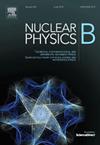Warm non-minimally coupled Peccei–Quinn inflation and de Sitter Swampland conjecture
IF 2.5
3区 物理与天体物理
Q2 PHYSICS, PARTICLES & FIELDS
引用次数: 0
Abstract
In this study, we explore the dynamics of warm inflation within a non-minimally coupled Peccei–Quinn (PQ) framework and evaluate its compatibility with the de Sitter Swampland Conjecture. Our model incorporates a PQ scalar field that is non-minimally coupled to gravity, facilitating inflation through a dissipative process that sustains a thermal bath, thereby distinguishing it from conventional cold inflation. We analyze the dissipation coefficient defined as , where is a dimensionless constant, M is a mass scale, and n and p are numerical powers. Our investigation focuses on three specific cases: (a) A temperature-dependent dissipation coefficient with an inverse relation, , where and ; (b) A dissipation coefficient linear in field ϕ, , where and ; and (c) A dissipation coefficient linear in temperature T, , where and . By examining the slow-roll dynamics in these inflationary scenarios, we derive essential cosmological parameters, including the scalar spectral index and the tensor-to-scalar ratio. We compare our results with the latest observational data from Planck 2018. Our findings suggest that the model is consistent with observational constraints while simultaneously satisfying the de Sitter Swampland conditions.
求助全文
约1分钟内获得全文
求助全文
来源期刊

Nuclear Physics B
物理-物理:粒子与场物理
CiteScore
5.50
自引率
7.10%
发文量
302
审稿时长
1 months
期刊介绍:
Nuclear Physics B focuses on the domain of high energy physics, quantum field theory, statistical systems, and mathematical physics, and includes four main sections: high energy physics - phenomenology, high energy physics - theory, high energy physics - experiment, and quantum field theory, statistical systems, and mathematical physics. The emphasis is on original research papers (Frontiers Articles or Full Length Articles), but Review Articles are also welcome.
 求助内容:
求助内容: 应助结果提醒方式:
应助结果提醒方式:


